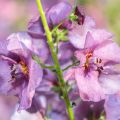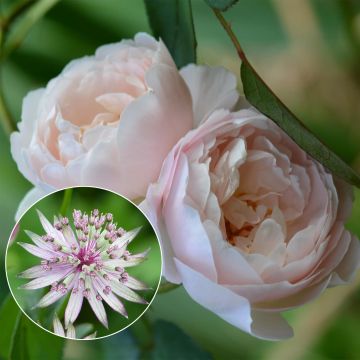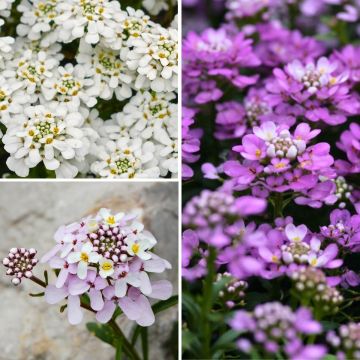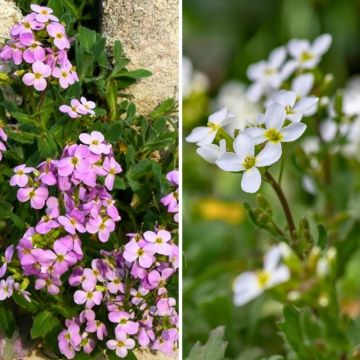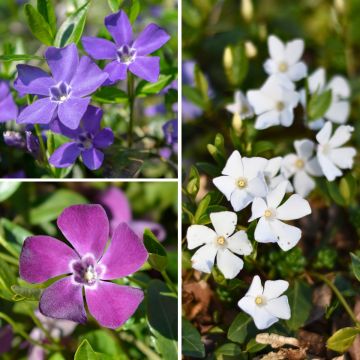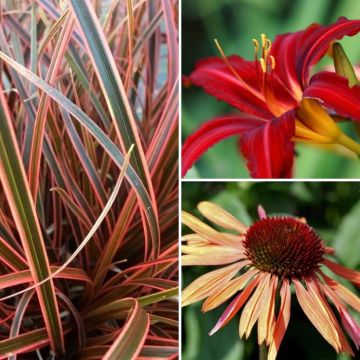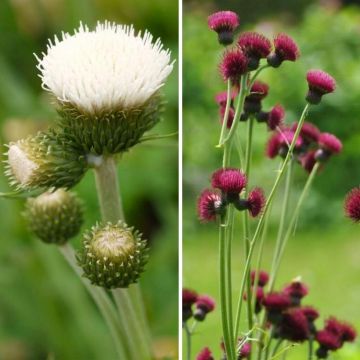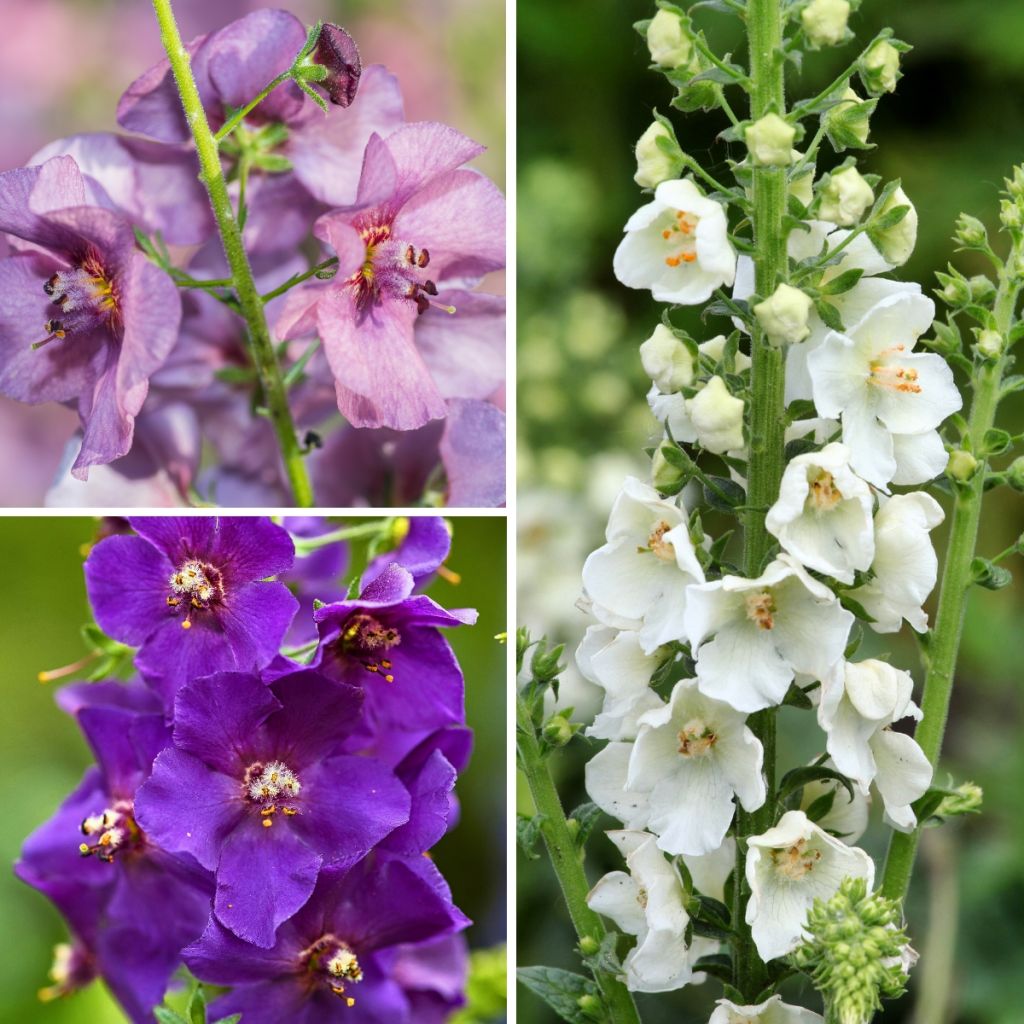

Hybrid Verbascum Collection
Hybrid Verbascum Collection
Verbascum (x) phoeniceum Flush of White, Violetta, Pink Domino
Ornamental Mullein
This item cannot be shipped to the selected country
Delivery charge from €5.90
Delivery to Corse prohibited
More information
Delivery charge from €5.90
Delivery to Corse prohibited
More information
Schedule delivery date,
and select date in basket
This plant carries a 12 months recovery warranty
More information
We guarantee the quality of our plants for a full growing cycle, and will replace at our expense any plant that fails to recover under normal climatic and planting conditions.
From €5.90 for pickup delivery and €6.90 for home delivery
Express home delivery from €8.90.
Delivery to Corse prohibited: UE law prohibits the import of this plant from mainland France to Corse as part of the fight against Xylella fastidiosa. Please accept our sincere apologies.
More information
Does this plant fit my garden?
Set up your Plantfit profile →
Collection items (3 plants)
Description
This collection of hybrid Verbascum offers a range of vibrant colours and long-lasting flowering. Consisting of the varieties Verbascum (x) phoeniceum 'Flush of White', 'Violetta', and 'Pink Domino', this collection will provide full satisfaction in sunny areas of the garden with well-drained soil, particularly in rockeries or raised borders. Their dark green basal foliage is deciduous to semi-evergreen, providing an interesting visual contrast with the flowers. Hardy down to -15°C (5°F), they also tolerate some drought. Though perennials, mulleins do not survive heavy and moist soil for long, faring instead much better in light or even poor soil. The plants readily self-seed in light soil and usually flower within the year of sowing.
The collection consists of:
1 x Verbascum phoeniceum 'Flush of White': this variety is distinguished by its pure white flowers and medium height of 70 cm (28in). Its dark green foliage forms an excellent contrast with its bright flowers.
1 x Verbascum phoeniceum 'Violetta': characterised by the beautiful dark violet hue of its flowers and a slightly shorter height, around 60-65 cm (24-26in), ideal for borders and mass planting.
1 x Verbascum phoeniceum 'Pink Domino': produces fresh pink flowers with a darker centre, and its height can reach up to 1 m (3ft), making it the tallest in the collection.
These hybrid verbascum can be planted in spring or autumn, preferring spring in colder regions and autumn in hot and dry climates. They thrive particularly well in rockeries, raised beds, or gravel borders. These plants love sunlight and well-drained soil. For a harmonious arrangement, place the tallest varieties, such as 'Pink Domino', at the back of your display. Allow approximately 3 to 5 plants per square metre and keep a distance of at least 40 cm (16in) between each plant.
Combine these mullein with plants that have similar soil and exposure requirements. The Geranium 'Rozanne' with blue flowers creates a beautiful contrast to the mullein and should ideally be placed in front of them along the border. The Fescue 'Elijah Blue' with its blue-grey foliage adds a different texture and blends well with the verbascum for a more natural effect. The lavandin 'Grosso' with violet flowers completes the colour palette of the mullein and can be planted behind them to add height and fragrance to the overall display. Finally, the sage 'Mainacht' with its dark purple spikes of flowers can be planted between the lavandins for a sense of depth, with its dark colour accentuating the lighter tones of the verbascum. By combining these different plants with this collection, you will create a rich and balanced masterpiece.
All in all, the hybrid Verbascum collection is a wise choice for gardeners looking to inject a diversity of colours into their green spaces while minimising maintenance requirements.
Flowering
Foliage
Plant habit
Botanical data
Verbascum
(x) phoeniceum
Flush of White, Violetta, Pink Domino
Scrophulariaceae
Ornamental Mullein
Cultivar or hybrid
Other Perennial collections
Planting and care
Verbascum should be grown in full sun or, at most, partial shade in a warm climate. These Mullein should preferably be planted in spring, in ordinary soil, but well loosened, properly drained, and which does not retain too much water. They prefer chalky, cool to dry soil, where they will readily self-seed (the colour of the flowers will be a surprise... for inquisitive gardeners). They cannot tolerate waterlogged soils in winter, which can often be fatal. Cut back faded inflorescences at the base of the stems to promote new flower growth and plant longevity. Prune any dry stems as soon as they are no longer attractive, and clear the clump at the latest in late winter.
Planting period
Intended location
Care
This item has not been reviewed yet - be the first to leave a review about it.
Haven't found what you were looking for?
Hardiness is the lowest winter temperature a plant can endure without suffering serious damage or even dying. However, hardiness is affected by location (a sheltered area, such as a patio), protection (winter cover) and soil type (hardiness is improved by well-drained soil).

Photo Sharing Terms & Conditions
In order to encourage gardeners to interact and share their experiences, Promesse de fleurs offers various media enabling content to be uploaded onto its Site - in particular via the ‘Photo sharing’ module.
The User agrees to refrain from:
- Posting any content that is illegal, prejudicial, insulting, racist, inciteful to hatred, revisionist, contrary to public decency, that infringes on privacy or on the privacy rights of third parties, in particular the publicity rights of persons and goods, intellectual property rights, or the right to privacy.
- Submitting content on behalf of a third party;
- Impersonate the identity of a third party and/or publish any personal information about a third party;
In general, the User undertakes to refrain from any unethical behaviour.
All Content (in particular text, comments, files, images, photos, videos, creative works, etc.), which may be subject to property or intellectual property rights, image or other private rights, shall remain the property of the User, subject to the limited rights granted by the terms of the licence granted by Promesse de fleurs as stated below. Users are at liberty to publish or not to publish such Content on the Site, notably via the ‘Photo Sharing’ facility, and accept that this Content shall be made public and freely accessible, notably on the Internet.
Users further acknowledge, undertake to have ,and guarantee that they hold all necessary rights and permissions to publish such material on the Site, in particular with regard to the legislation in force pertaining to any privacy, property, intellectual property, image, or contractual rights, or rights of any other nature. By publishing such Content on the Site, Users acknowledge accepting full liability as publishers of the Content within the meaning of the law, and grant Promesse de fleurs, free of charge, an inclusive, worldwide licence for the said Content for the entire duration of its publication, including all reproduction, representation, up/downloading, displaying, performing, transmission, and storage rights.
Users also grant permission for their name to be linked to the Content and accept that this link may not always be made available.
By engaging in posting material, Users consent to their Content becoming automatically accessible on the Internet, in particular on other sites and/or blogs and/or web pages of the Promesse de fleurs site, including in particular social pages and the Promesse de fleurs catalogue.
Users may secure the removal of entrusted content free of charge by issuing a simple request via our contact form.



































